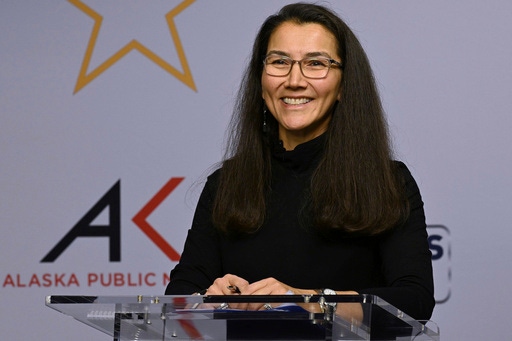AP Decision Notes: What to expect in Alaska on Election Day
WASHINGTON (AP) — Alaska voters will decide in the Nov. 5 general election which presidential candidate will receive the state’s three electoral votes, but the race for the sole U.S. House seat might have bigger national implications.
Republicans hold a slim majority in the U.S. House, and control of the chamber in the next Congress could come down to whether Democratic U.S. Rep. Mary Peltola can fend off a competitive challenge from Republican Nick Begich under the state’s ranked-choice voting system.
Peltola first won the seat in a 2022 special election following the death of longtime Republican congressman Don Young. She defeated a field that included both Begich and former GOP governor and 2008 vice presidential nominee Sarah Palin.
In Alaska, every candidate runs on the same primary ballot, regardless of party affiliation. The four candidates who win the most votes automatically advance to the general election, when voters can rank them in order of preference on the ballot.
In this year’s U.S. House race, Peltola won just over half of August’s all-party primary vote and advanced to the general election with Begich and two other Republicans, Lt. Gov. Nancy Dahlstrom and Matthew Salisbury. Dahlstrom and Salisbury dropped out of the race after the primary, advancing the fifth- and sixth-place candidates to the general election and leaving Begich the sole remaining Republican in the race.
Replacing Dahlstrom and Salisbury on the ballot are Alaskan Independence Party chairman John Wayne Howe and Eric Hafner, a Democrat who received less than half a percentage point of the vote in the primary. Hafner is serving a 20-year prison sentence in New York for threatening officials in New Jersey.
Peltola and Begich are the best-known and best-funded candidates. But the two lesser-known candidates could thwart Peltola or Begich from surpassing 50% of the vote. In that event, the race would go to ranked-choice voting.
The votes released on election night are technically voters’ first-choice candidates. Under ranked-choice voting, the state eliminates the candidate with the fewest votes on election night from contention. Voters whose first choice was eliminated will have their votes redistributed to their second-choice candidate. That process continues until a candidate surpasses a majority of the vote. The state Division of Elections says the results of the ranked-choice voting process will be released on Nov. 20.
On the presidential ballot, voters will have the option to rank Republican former President Donald Trump, Democratic Vice President Kamala Harris, and six third-party candidates.
Voters will also weigh in on an initiative that eliminates ranked-choice voting and restores the traditional, single-choice system. It would also eliminate open primary elections in which all candidates appear on the same ballot, regardless of party affiliation.
Here’s a look at what to expect in the 2024 election in Alaska:
Election Day
Nov. 5.
Poll closing time
12 a.m. and 1 a.m. ET. Alaska covers two time zones. Votes could be released as early as 45 minutes after voting ends in the first time zone, at midnight ET.
Presidential electoral votes
3 awarded to statewide winner.
Key races and candidates
President: Harris (D) vs. Trump (R) vs. Robert F. Kennedy Jr. vs. Chase Oliver (Libertarian) vs. Jill Stein vs. Cornel West (Aurora) and two others.
At-large Congressional District: Peltola (D) vs. Begich (R) vs. John Wayne Howe (AK Independence) vs. Hafner (D).
Ballot measures: Measure 2 (repeal ranked-choice voting).
Other races of interest
State Senate, state House and one other ballot measure.
Past presidential results
2020: Trump (R) 53%, Biden (D) 43%, AP race call: Wednesday, Nov. 11, 2020, 12:17 p.m. ET.
Voter registration and turnout
Registered voters: 609,933 (as of Oct. 3, 2024). About 12% Democrats, 24% Republicans, 45% undeclared and 14% nonpartisan.
Voter turnout in 2020 presidential election: 60% of registered voters.
Pre-Election Day voting
Votes cast before Election Day 2020: about 53% of the total vote.
Votes cast before Election Day 2022: about 35% of the total vote.
Votes cast before Election Day 2024: See AP Advance Vote tracker.
How long does vote-counting take?
First votes reported, Nov. 3, 2020: 1:15 a.m. ET. on Wednesday, Nov. 4.
By 6 a.m. ET on Nov. 4: about 44% of total votes cast were reported.
___
AP writers Hannah Fingerhut and Maya Sweedler contributed to this report.
___
Read more about how U.S. elections work at Explaining Election 2024, a series from The Associated Press aimed at helping make sense of the American democracy. The AP receives support from several private foundations to enhance its explanatory coverage of elections and democracy. See more about AP’s democracy initiative here. The AP is solely responsible for all content.
Copyright 2024 The Associated Press. All rights reserved. This material may not be published, broadcast, rewritten or redistributed without permission.

